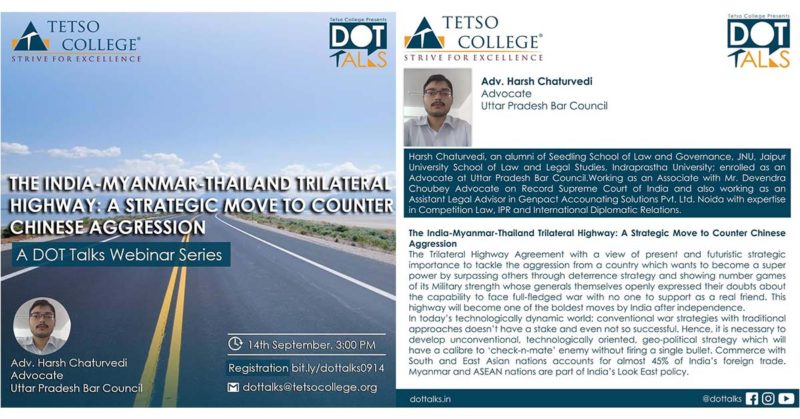This DOT Talks webinar was held on 14th September 2020 on the topic ‘The India-Myanmar-Thailand Trilateral Highway: A Strategic Move to Counter Chinese Aggression’ with Harsh Chaturvedi, an advocate at Uttar Pradesh Bar Council, as the main resource speaker.
Giving a brief history of the conflict between India and China, Chaturvedi stated that border disputes arose as early as 1914 between the then British India and China. Later, the Indo-China War took place in 1962 which also led to the formation of the Line of Actual Control, he said. Chaturvedi recalled that there has been a number of disputes such as the Sikkim dispute in 1967, a stand-off at Daulat Beg Oldi in 2013, and the most recent stand-off at Ladakh this year.
Chaturvedi made strong points about The Trilateral Highway Agreement with a view of present and futuristic strategic importance to tackle the aggression from China which wants to become a super power by surpassing others through deterrence strategy, he said. The trilateral highway will connect Moreh, India with Mae Sot, Thailand via Myanmar and is a part of India’s Look East Policy that will cultivate and strengthen economic and strategic relations with the nations of Southeast Asian countries in order to solidify its standing as a regional power, he added. A Motor Vehicles Agreement along with protocols for regulating and facilitating movement of cargo and passenger vehicular traffic is under inter-governmental negotiations between India, Myanmar and Thailand and the National Highways Authority of India (NHAI) has been appointed as the technical executing agency and project management consultant, he said. It will be a four-lane highway which is approximately 1,360 km (850 miles).
Meanwhile, this project will also help Indian position as a counterweight to the strategic influence of the People’s Republic of China in the region and suppressing weak countries under its number game deterrence, he observed.
The resource speaker also spoke on the topic of India’s Act East Policy which aims to establish commerce with South and East Asian nations and accounts for almost 45% of India’s foreign trade. India is part of BIMSTEC, East Asia Summit, Mekong-Ganga Cooperation, United Nations Economic and Social Commission for Asia and the Pacific, Asian Highway Network and the Trans-Asian Railway network and India has embarked on several Look-East connectivity projects, he added.
This project will boost trade and commerce in the ASEAN–India Free Trade Area, as well as with the rest of Southeast Asia and most importantly it will create a humongous barrier for China to execute its geo-strategic interests and policies. This is one of the smartest and visionary moves that the Government of India has ever made to check the expansionist and imperial ambitions of China, Chaturvedi concluded.

